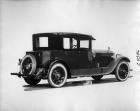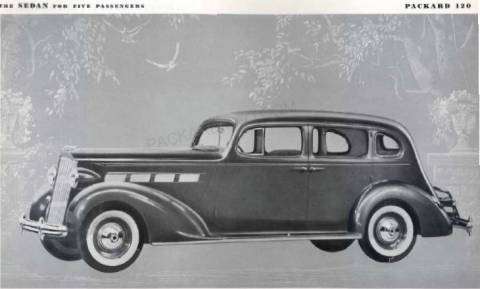|
Re: Engine Timing
|
||||
|---|---|---|---|---|
|
Home away from home
|
Thank you for that tutelage, John. How do I check to see if the vacuum advance is actually ADVANCING?? I notice a slight increase in RPM's when I hook the vacuum back up after engine timing so I THINK it's working. Also, have sucked on the vacuum line with the distributor cap off and I can see the cage move. I guess the question is: how much?? Is it enough vacuum? and how to measure that? (I do not have a vacuum gauge, although it is something I have contemplated buying)
Chris
Posted on: 2020/3/28 13:17
|
|||
|
'If you think you can, or you think you can't - you're right!' Henry Ford.
1939 Packard Six, Model 1700 |
||||
|
||||
|
Re: Engine Timing
|
||||
|---|---|---|---|---|
|
Home away from home
|
Here' some more back-ground information that applies to the later Delco vacuum chambers.
Roughly seven years ago my '54 Cavalier's vacuum advance stopped working, and I ordered a replacement unit from one of our favorite Packard specialty houses. That gave me the opportunity to have a 'side by side' comparison of the two units. What I noticed is the number stamped on the operating arm was different. The failed unit had an arm marked 56, while the replacement's arm was marked 215. The replacement chamber fit the distributor OK, but I was inclined to make a few measurements . . . . The arm attaches to the backing plate approximately 1.280 inches from the centerline of the distributor shaft, which equates to approximately 0.0224 inch stroke per degree rotation of the breaker plate. I measured the maximum stroke on both units and found the stroke of the #56 unit was 0.260 inch, and the stroke of the #215 unit was 0.102 inch . . . less than ? of the #56 unit, how could that be ????. So the question became "What controls the maximum stroke of the vacuum chamber?". It turns out the answer appears to be the arm itself limits the stroke, at least on the later Delco units. There is not an adjustable internal stop. I suspect when a vacuum chamber is overhauled the arm is separated from the diaphragm, and subsequently re-riveted to the new diaphragm. The rest of the non-moving housing appears to be identical. I've assumed that Delco responded to the engine manufacture's specifications by changing the free length and stiffness of the internal spring, and limited the total stroke with the arm geometry. I've concluded that over the years the significances of the arm geometry to the applicability may have been lost. In the mean time I've made a few adjustable internal stops that fit inside the fitting, but I'm not completely sure more advance at high vacuum is detrimental. By virtue of the #215 arm, right now I'm running about ? of the maximum vacuum advance specified by Packard . . . I can't tell the difference, and perhaps I never drove the car with the correct vacuum advance. Has anyone run-into Delco vacuum chambers that either had too much, or not enough stroke? Does anyone have a detailed listing of Delco 'arm number' to engine application? See the '54 Packard Service Manual Section VIII Electrical, Figure 31 (Delco) and Figure 32 (AutoLite), and the artwork in the attached file.
Posted on: 2020/3/28 17:27
|
|||
|
||||
|
Re: Engine Timing
|
||||
|---|---|---|---|---|
|
Home away from home
|
Thanks, Pat. I THINK I have a somewhat better understanding of what it's all about and I shall try and implement what has been suggested. As previously stated, I got my hands on my newly rebuilt carb yesterday and I will be reinstalling that and doing a little mini-tuneup for spring with some new plugs, etc. I will throw the timing light on it at that time and see what I can see. In the meantime, I am over on Vancouver Island dealing with my boat, which just happened to need hauled out to have the bottom redone this year PLUS a 5-year appraiser's survey for the insurance company came due this year as well, so I am dealing with all THAT in the confines of Covid 19 distancing and isolation rules. Not an easy task. We had to take the ferry over from the mainland and that involved having to stay in your vehicle in the hold of the ship for the entire two-hour crossing. I only say this here as everyone is involved in the 'new normal' of this pandemic, and things that were simple and commonplace before become a big deal. I know it's obvious, but that this site is safe from any risk, is of some comfort in light of ALL the other things that we're all doing to try and stay safe. I just received an email from a close friend in Spain and he said somebody is dying from this every 2 minutes there and the relatively small country has 15 X's the number of cases that the entire country of Canada is dealing with. Yet there are still folks out there who are not taking this seriously. Not sure what it will take to wake them up, but all I can say is PLEASE stay safe out there!! Chris.
Posted on: 2020/3/28 17:28
|
|||
|
'If you think you can, or you think you can't - you're right!' Henry Ford.
1939 Packard Six, Model 1700 |
||||
|
||||
|
Re: Engine Timing
|
||||
|---|---|---|---|---|
|
Home away from home
|
That is interesting stuff, David Packard; thanks for posting. Not knowing all the intricacies of how a vacuum advance does what it does, I'm not sure I follow all that you're saying. I have an Autolite distributor (I think a 4201) that I got as NOS from Packard Don and it was like new inside, obviously not used. Like I say, I checked that the advance pot was working by sucking on the advance line and the distributor definitely advanced and when I let off, it snapped back briskly, so I was comfortable that it was at least doing SOMETHING. The issue would be an old diaphragm not being as elastomeric as when new (no fault of the unit, given it's age) and thus the travel diminished. It is beyond me how I would test and measure the pot's travel and, at the end of the day, if I could just buy a new (and I mean recently manufactured, not NOS) vacuum pot, that was CORRECT, I would just buy it and be done with the testing. I think I will invest in a vacuum gauge so I can at least check the vacuum AMOUNT in inches and make sure I am at least to-spec, and go from there. Anybody know of a pot that can be had, that would be CORRECT for the Auotlite distributor? And is there any advice on one type or brand of vacuum gauge being any better than another?? Appreciate any input or advice - Thanks. Chris.
Posted on: 2020/3/28 18:46
|
|||
|
'If you think you can, or you think you can't - you're right!' Henry Ford.
1939 Packard Six, Model 1700 |
||||
|
||||
|
Re: Engine Timing
|
||||
|---|---|---|---|---|
|
Home away from home
|
Chris;
I also will plead insufficient experience on AutoLite vacuum chambers when it comes to what sets the upper stop (full vacuum applied). The dominate failure mode on these chambers is a ruptured diaphragm, which results in zero movement. At least on an AutoLite distributor the motion is observable . . . not so on a Delco distributor. The purpose of my posting was more of a 'look out for this' when one of the members was changing a broken chamber on a Delco distributor. My experience was, just because it fits doesn't mean the calibration is correct. Seems that you have conducted all of the right checks, that is, it holds a vacuum and springs back only when the vacuum is released. dp
Posted on: 2020/3/28 19:15
|
|||
|
||||
|
Re: Engine Timing
|
||||
|---|---|---|---|---|
|
Home away from home
|
Alright David, thanks. I will forge 'onward through the fog'!!! LOL Chris.
Posted on: 2020/3/28 20:02
|
|||
|
'If you think you can, or you think you can't - you're right!' Henry Ford.
1939 Packard Six, Model 1700 |
||||
|
||||
|
Re: Engine Timing
|
||||
|---|---|---|---|---|
|
Home away from home
|
The 1939 Six that I had used one of the tiny Autolite distributors without vacuum advance. It was fully mechanical! The car is long gone but I still have the distributor.
Posted on: 2020/3/28 21:08
|
|||
|
||||
|
Re: Engine Timing
|
||||
|---|---|---|---|---|
|
Home away from home
|
Don, the two Auto-lite distributors that I can find referenced for the '39 Six are the IGS-4013 and the IGS-4201. Both have vacuum pots. They use different points and when I got my car the ident plate was missing from the distributor. I was able to narrow it down by identifying the points and confirm it was a 4201. That is the unit you had as NOS, and which I purchased from you a couple of years back (actually it was February of 2017!!) Chris.
Posted on: 2020/3/28 23:47
|
|||
|
'If you think you can, or you think you can't - you're right!' Henry Ford.
1939 Packard Six, Model 1700 |
||||
|
||||
|
Re: Engine Timing
|
||||
|---|---|---|---|---|
|
Home away from home
|
Chris, it was in my 1939 Six when I bought it in or abound 1966 but the engine was a 1940 110. As best I can tell, the Autolite number is GW4143 with a few more digits spaced out after that.
Posted on: 2020/3/29 1:45
|
|||
|
||||










